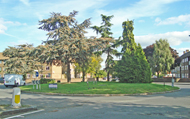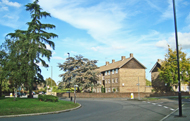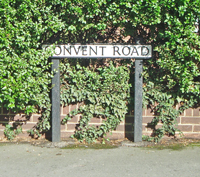Ecclesfield
(including St Joseph's Reformatory)
(including St Joseph's Reformatory)
Feltham Hill Road, Ashford, Middlesex
TW15
Medical
dates:
Medical
character:
Rehabilitation (Roman Catholic female inebriates)
In March 1899, under the orders
of Cardinal
Vaughan, the Sisters of the Order of the Good
Shepherd
acquired Ecclesfield, a commodious mansion with a lodge and
cottages in 45 acres of grounds, in order to establish a convent and a
Certified Inebriate Reformatory for Roman Catholic women.
A team of experienced Sisters was sent to establish the Reformatory. Alterations were made to the mansion to provide temporary accommodation for the inmates. An existing room was enlarged for use as a Dining Room, a workroom and a Recreation Room. Another team of Sisters set up a laundry in the lodge until a permanent building for it could be built.
Named St Joseph's Reformatory, it opened on 8th April 1899 with 50 beds. Roman Catholic women from any county in England and Wales were eligible for admission if their local authority was willing to pay 7 shillings (35p) a week towards their keep. The first patients were admitted under the Act in May and, by August, there were 25 inmates. By the end of the year there were 42 women, who were expected to remain for at least a year.
A laundry, large dormitory and chapel were added to the main building. The large chapel was open to the public, but arranged to keep the inmates unseen from the external worshippers.
As it was a religious establishment, only Roman Catholics were admitted and the Reformatory was never more than two-thirds occupied. By 1900 it had 75 beds, but only 36 inmates. In September of that year a site for a church was purchased, and the building was completed three months later in December.
In 1901 there were only 24 admissions and, in 1902, 53 admissions, of which 10 were re-admissions.
However, the women sent from the courts proved to be of too rough a character for the Sisters' methods. Most were of the lowest class of prostitute, many with syphilis or gonorrhoea, and needed stricter management than the Sisters could enforce. The laundry, intended to make the Reformatory self-supporting, was also in trouble as the inmates, unused to such physical labour, were too debilitated to work.
It was decided to cease admissions from the courts after December 1903. When the last of these were discharged in 1906, the institution ceased to be a Certified Inebriate Reformatory; thereafter, only cases which had been assessed at a classification centre and deemed to be 'reformable' were admitted.
Because the laundry was failing to pay, it was also decided to establish a home for 'ladies of a better class' who would submit themselves voluntarily under the 1879 Act. In 1904 an appeal was launched to raise funds for an institution which would house 200 penitents.
Early in 1905 the site was split into two parts - St Joseph's Reformatory for working-class inebriates (who ran the laundry) and Ecclesfield (Home of the Good Shepherd), a retreat for 65 middle-class women who had been admitted voluntarily.
The Sisters divided the inmates of Ecclesfield into two classes. Those in the Sacred Heart Class paid the most and did not engage in manual labour. The second group - St Joseph's Class - could afford to pay little or nothing, but earned their keep by undertaking domestic work for the Sacred Heart Class. The group in St Joseph's Reformatory (the traditional type of voluntary penitents) were designated as Our Lady's Class. Thus, from being a Certified Inebriate Reformatory, the institution became a three-class Retreat.
In October 1907 the laundry - a main source of income for the institution - caught fire. Everything - the machinery, laundry utensils and most of the linen sent to be washed - was destroyed, as was the Recreation Room. The 50 penitents, who had been at dinner at the time, lost all their worldly possessions, including their clothes which had been stored away until they left the Reformatory. All the winter clothes they had prepared for the coming winter were also lost.
The Sisters estimated that insurance money would be sufficient to repay the money they had borrowed to install and furnish the laundry, and to compensate those whose property had been destroyed. However, in the meantime, they had to provide for the 50 girls and women. An appeal was launched for funds to feed and clothe them for one month. If there was no immediate prospect of rebuilding the laundry, the penitents would have to be disbanded. In the event, the laundry was rebuilt.
By 1913 the Retreat was charging its middle-class inmates from 12s 6d (63p) to 2 guineas (£2.10) a week, admitting those suffering from inebriation, drug addiction and 'nerves'. It remained under the patronage of the Archbishop of Westminster.
In 1921 the chapel was destroyed by a fire. It was rebuilt and was officially reopened in May 1922 by the Archbishop.
By the mid 1920s the Retreat had some 90 to 100 upper and middle class patients (those of lower status were not admitted - they were sent to the Reformatory to do laundry work). Of this number, a third were cured and a third improved; treatment of the remaining third proved completely useless.
On admission, patients were purged. Bromides (sedatives) and hyoscyamus and sal volatile were given every two hours. These were continued from 3 to 6 weeks, as necessary, after which simple tonics were then given. The usual stimulant nourishments were supplied and, for a short time, whatever stimulant the patient had been taking prior to admission. This was then tapered off and, once ceased, spartein sulphate injections were given.
Inmates were kept busy - addressing envelopes, doing needle- or raffia work, painting, sketching, providing entertainments (plays and concerts) for themselves or playing cards.
In 1936 the convent and Retreat moved to Staplehurst, near Tonbridge, in Kent. The Reformatory presumably closed.
A team of experienced Sisters was sent to establish the Reformatory. Alterations were made to the mansion to provide temporary accommodation for the inmates. An existing room was enlarged for use as a Dining Room, a workroom and a Recreation Room. Another team of Sisters set up a laundry in the lodge until a permanent building for it could be built.
Named St Joseph's Reformatory, it opened on 8th April 1899 with 50 beds. Roman Catholic women from any county in England and Wales were eligible for admission if their local authority was willing to pay 7 shillings (35p) a week towards their keep. The first patients were admitted under the Act in May and, by August, there were 25 inmates. By the end of the year there were 42 women, who were expected to remain for at least a year.
A laundry, large dormitory and chapel were added to the main building. The large chapel was open to the public, but arranged to keep the inmates unseen from the external worshippers.
As it was a religious establishment, only Roman Catholics were admitted and the Reformatory was never more than two-thirds occupied. By 1900 it had 75 beds, but only 36 inmates. In September of that year a site for a church was purchased, and the building was completed three months later in December.
In 1901 there were only 24 admissions and, in 1902, 53 admissions, of which 10 were re-admissions.
However, the women sent from the courts proved to be of too rough a character for the Sisters' methods. Most were of the lowest class of prostitute, many with syphilis or gonorrhoea, and needed stricter management than the Sisters could enforce. The laundry, intended to make the Reformatory self-supporting, was also in trouble as the inmates, unused to such physical labour, were too debilitated to work.
It was decided to cease admissions from the courts after December 1903. When the last of these were discharged in 1906, the institution ceased to be a Certified Inebriate Reformatory; thereafter, only cases which had been assessed at a classification centre and deemed to be 'reformable' were admitted.
Because the laundry was failing to pay, it was also decided to establish a home for 'ladies of a better class' who would submit themselves voluntarily under the 1879 Act. In 1904 an appeal was launched to raise funds for an institution which would house 200 penitents.
Early in 1905 the site was split into two parts - St Joseph's Reformatory for working-class inebriates (who ran the laundry) and Ecclesfield (Home of the Good Shepherd), a retreat for 65 middle-class women who had been admitted voluntarily.
The Sisters divided the inmates of Ecclesfield into two classes. Those in the Sacred Heart Class paid the most and did not engage in manual labour. The second group - St Joseph's Class - could afford to pay little or nothing, but earned their keep by undertaking domestic work for the Sacred Heart Class. The group in St Joseph's Reformatory (the traditional type of voluntary penitents) were designated as Our Lady's Class. Thus, from being a Certified Inebriate Reformatory, the institution became a three-class Retreat.
In October 1907 the laundry - a main source of income for the institution - caught fire. Everything - the machinery, laundry utensils and most of the linen sent to be washed - was destroyed, as was the Recreation Room. The 50 penitents, who had been at dinner at the time, lost all their worldly possessions, including their clothes which had been stored away until they left the Reformatory. All the winter clothes they had prepared for the coming winter were also lost.
The Sisters estimated that insurance money would be sufficient to repay the money they had borrowed to install and furnish the laundry, and to compensate those whose property had been destroyed. However, in the meantime, they had to provide for the 50 girls and women. An appeal was launched for funds to feed and clothe them for one month. If there was no immediate prospect of rebuilding the laundry, the penitents would have to be disbanded. In the event, the laundry was rebuilt.
By 1913 the Retreat was charging its middle-class inmates from 12s 6d (63p) to 2 guineas (£2.10) a week, admitting those suffering from inebriation, drug addiction and 'nerves'. It remained under the patronage of the Archbishop of Westminster.
In 1921 the chapel was destroyed by a fire. It was rebuilt and was officially reopened in May 1922 by the Archbishop.
By the mid 1920s the Retreat had some 90 to 100 upper and middle class patients (those of lower status were not admitted - they were sent to the Reformatory to do laundry work). Of this number, a third were cured and a third improved; treatment of the remaining third proved completely useless.
On admission, patients were purged. Bromides (sedatives) and hyoscyamus and sal volatile were given every two hours. These were continued from 3 to 6 weeks, as necessary, after which simple tonics were then given. The usual stimulant nourishments were supplied and, for a short time, whatever stimulant the patient had been taking prior to admission. This was then tapered off and, once ceased, spartein sulphate injections were given.
Inmates were kept busy - addressing envelopes, doing needle- or raffia work, painting, sketching, providing entertainments (plays and concerts) for themselves or playing cards.
In 1936 the convent and Retreat moved to Staplehurst, near Tonbridge, in Kent. The Reformatory presumably closed.
Present status (October 2012)
The buildings have been demolished and their site is now occupied by a roundabout, a street (Town Tree Road) and council housing. The convent is remembered in the name Convent Road.


The roundabout (left)and new housing (right), as seen from Feltham Hill Road, occupy the southwest corner of the site of the convent.

Town Tree Road was built on the grounds of the former convent.

Convent Road commemorates the site.
(Author unstated) 1899 The Inebriates Act. British Medical Journal 2 (2009), 27-28.
(Author unstated) 1900 The Inebriates Act, 1898. British Medical Journal 1 (2048), 781.
(Author unstated) 1900 The treatment of inebriety in institutions. British Medical Journal 2 (2077), 1198-1200.
(Author unstated) 1913 Home for ladies. London Monitor and New Era, 26th April, 8.
Burnand FC (ed) 1908 The Catholic Who's Who Year Book. London, Burns & Gates. p.50.
Hughes PE 1985 Cleanliness and Godliness: a sociological study of the Good Shepherd Convent refuges for the social reformation and Christian conversion of prostitutes and convicted women in nineteenth century Britain. Brunel University, unpublished thesis.
Kelly BW 1907 Historical notes on English Catholic Missions. London, Kegan Paul, Trench, Truebner & Co.
Mother Prioress 1904 Home for Penitents. London Monitor and New Era, 2nd December, 8.
Parliamentary Papers 1910 Report of the Inspector under the Inebriates Acts, 1879 to 1900, for the year 1908. London, H.M.S.O.
Reid J 1926 The treatment of female inebriates and drug addicts. British Journal of Inebriety 24, 58-62.
http://archive.thetablet.co.uk (1)
http://archive.thetablet.co.uk (2)
http://archive.thetablet.co.uk (3)
http://parish.rcdow.org.uk
http://tablet.archive.netcopy.co.uk
http://taking-stock.org.uk
www.getsurrey.co.uk
www.institutions.org.uk
www.stmatthewashford.org.uk
www.thegazette.co.uk
Return to home page